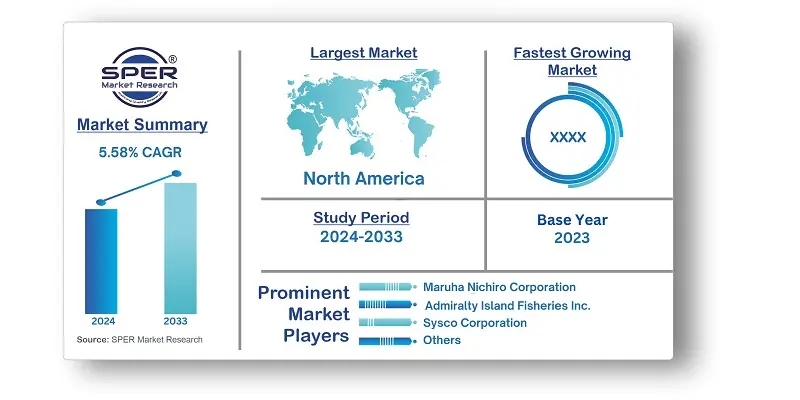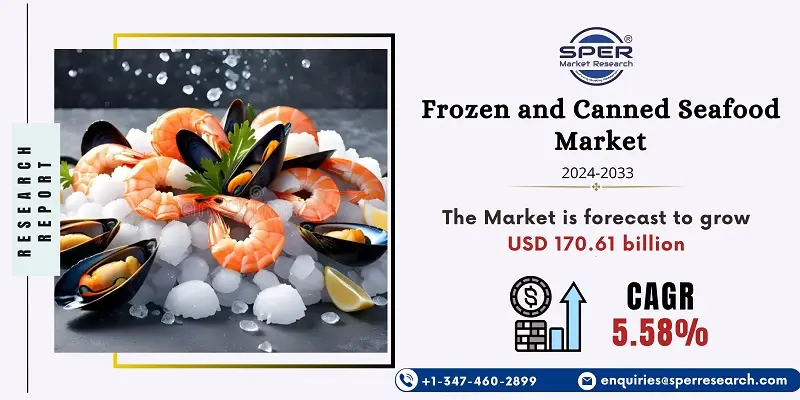
Frozen and Canned Seafood Market Trends, Size, Growth, Share, Demand and Future Outlook
Frozen and Canned Seafood Market Growth, Size, Trends Analysis - By Type, By Distribution Channel - Regional Outlook, Competitive Strategies and Segment Forecast to 2033
| Published: Nov-2024 | Report ID: FOOD24126 | Pages: 1 - 246 | Formats*: |
| Category : Food & Beverages | |||
- August 2022: Bolton Group purchased Wild Planet Foods, a leader in innovation and a pioneer in the US market for canned seafood that is naturally and sustainably harvested. In the future, Bolton Group and Wild Planet will collaborate to create a sustainable supply chain that is among the finest in its class.
- June 2022: A new joint venture business, ATLAND Corporation (ATLAND), specialising in land-based salmon production was announced by Mitsubishi Corporation (MC) and Maruha Nichiro Corporation (Maruha Nichiro).
- June 2022: Seafood Connection Holding BV (Seacon), a branch of Maruha Nichiro Corporation, acquired all of Northcoast Seafoods Ltd.'s shares. Northcoast joined the Maruha Nichiro Group as a result of this acquisition.


| Report Metric | Details |
| Market size available for years | 2020-2033 |
| Base year considered | 2023 |
| Forecast period | 2024-2033 |
| Segments covered | By Type, By Distribution Channel |
| Regions covered | North America, Asia-Pacific, Latin America, Middle East & Africa and Europe |
| Companies Covered | Maruha Nichiro Corporation, Mowi ASA, Nippon Suisan Kaisha Ltd, Sysco Corporation, Thai Union Group PCL, Admiralty Island Fisheries Inc., Bolton Group SRL, FCF CO. Ltd, Golden Prize Canning Company Limited, Others. |
- Retail Consumers
- Supermarkets and Hypermarkets
- Restaurants and Food Service Chains
- Hotels and Catering Services
- Health-Conscious Consumers
- Pet Food Manufacturers
- Online Grocery Retailers
- Institutional Buyers
- Distributors and Wholesalers
- Eco-conscious Consumers
| By Type: | |
| By Distribution Channel: |
- Global Frozen and Canned Seafood Market Size (FY’2024-FY’2033)
- Overview of Global Frozen and Canned Seafood Market
- Segmentation of Global Frozen and Canned Seafood Market By Type (Fish, Shrimp, Other Seafood)
- Segmentation of Global Frozen and Canned Seafood Market By Distribution Channel (Convenience Stores, Online Channel, Supermarkets and Hypermarkets, Others)
- Statistical Snap of Global Frozen and Canned Seafood Market
- Expansion Analysis of Global Frozen and Canned Seafood Market
- Problems and Obstacles in Global Frozen and Canned Seafood Market
- Competitive Landscape in the Global Frozen and Canned Seafood Market
- Impact of COVID-19 and Demonetization on Global Frozen and Canned Seafood Market
- Details on Current Investment in Global Frozen and Canned Seafood Market
- Competitive Analysis of Global Frozen and Canned Seafood Market
- Prominent Players in the Global Frozen and Canned Seafood Market
- SWOT Analysis of Global Frozen and Canned Seafood Market
- Global Frozen and Canned Seafood Market Future Outlook and Projections (FY’2024-FY’2033)
- Recommendations from Analyst
1.1. Scope of the report1.2. Market segment analysis
2.1. Research data source2.1.1. Secondary Data2.1.2. Primary Data2.1.3. SPER’s internal database2.1.4. Premium insight from KOL’s2.2. Market size estimation2.2.1. Top-down and Bottom-up approach2.3. Data triangulation
4.1. Driver, Restraint, Opportunity and Challenges analysis4.1.1. Drivers4.1.2. Restraints4.1.3. Opportunities4.1.4. Challenges4.2. COVID-19 Impacts of the Global Frozen and Canned Seafood Market
5.1. SWOT Analysis5.1.1. Strengths5.1.2. Weaknesses5.1.3. Opportunities5.1.4. Threats5.2. PESTEL Analysis5.2.1. Political Landscape5.2.2. Economic Landscape5.2.3. Social Landscape5.2.4. Technological Landscape5.2.5. Environmental Landscape5.2.6. Legal Landscape5.3. PORTER’s Five Forces5.3.1. Bargaining power of suppliers5.3.2. Bargaining power of buyers5.3.3. Threat of Substitute5.3.4. Threat of new entrant5.3.5. Competitive rivalry5.4. Heat Map Analysis
6.1. Global Frozen and Canned Seafood Market Manufacturing Base Distribution, Sales Area, Product Type6.2. Mergers & Acquisitions, Partnerships, Product Launch, and Collaboration in Global Frozen and Canned Seafood Market
7.1. Global Frozen and Canned Seafood Market Size, Share and Forecast, By Type, 2020-20267.2. Global Frozen and Canned Seafood Market Size, Share and Forecast, By Type, 2027-20337.3. Fish7.4. Shrimp7.5. Other Seafood
8.1. Global Frozen and Canned Seafood Market Size, Share and Forecast, By Distribution Channel, 2020-20268.2. Global Frozen and Canned Seafood Market Size, Share and Forecast, By Distribution Channel, 2027-20338.3. Convenience Stores8.4. Online Channel8.5. Supermarkets and Hypermarkets8.6. Others
9.1. Global Frozen and Canned Seafood Market Size and Market Share
10.1. Global Frozen and Canned Seafood Market Size and Market Share By Region (2020-2026)10.2. Global Frozen and Canned Seafood Market Size and Market Share By Region (2027-2033)10.3. Asia-Pacific10.3.1. Australia10.3.2. China10.3.3. India10.3.4. Japan10.3.5. South Korea10.3.6. Rest of Asia-Pacific10.4. Europe10.4.1. France10.4.2. Germany10.4.3. Italy10.4.4. Spain10.4.5. United Kingdom10.4.6. Rest of Europe10.5. Middle East and Africa10.5.1. Kingdom of Saudi Arabia10.5.2. United Arab Emirates10.5.3. Qatar10.5.4. South Africa10.5.5. Egypt10.5.6. Morocco10.5.7. Nigeria10.5.8. Rest of Middle-East and Africa10.6. North America10.6.1. Canada10.6.2. Mexico10.6.3. United States10.7. Latin America10.7.1. Argentina10.7.2. Brazil10.7.3. Rest of Latin America
11.1. Maruha Nichiro Corporation11.1.1. Company details11.1.2. Financial outlook11.1.3. Product summary11.1.4. Recent developments11.2. Mowi ASA11.2.1. Company details11.2.2. Financial outlook11.2.3. Product summary11.2.4. Recent developments11.3. Nippon Suisan Kaisha Ltd11.3.1. Company details11.3.2. Financial outlook11.3.3. Product summary11.3.4. Recent developments11.4. Sysco Corporation11.4.1. Company details11.4.2. Financial outlook11.4.3. Product summary11.4.4. Recent developments11.5. Thai Union Group PCL11.5.1. Company details11.5.2. Financial outlook11.5.3. Product summary11.5.4. Recent developments11.6. Admiralty Island Fisheries Inc.11.6.1. Company details11.6.2. Financial outlook11.6.3. Product summary11.6.4. Recent developments11.7. Bolton Group SRL11.7.1. Company details11.7.2. Financial outlook11.7.3. Product summary11.7.4. Recent developments11.8. FCF CO. Ltd11.8.1. Company details11.8.2. Financial outlook11.8.3. Product summary11.8.4. Recent developments11.9. Golden Prize Canning Company Limited11.9.1. Company details11.9.2. Financial outlook11.9.3. Product summary11.9.4. Recent developments11.10. Others
SPER Market Research’s methodology uses great emphasis on primary research to ensure that the market intelligence insights are up to date, reliable and accurate. Primary interviews are done with players involved in each phase of a supply chain to analyze the market forecasting. The secondary research method is used to help you fully understand how the future markets and the spending patterns look likes.
The report is based on in-depth qualitative and quantitative analysis of the Product Market. The quantitative analysis involves the application of various projection and sampling techniques. The qualitative analysis involves primary interviews, surveys, and vendor briefings. The data gathered as a result of these processes are validated through experts opinion. Our research methodology entails an ideal mixture of primary and secondary initiatives.



Frequently Asked Questions About This Report
PLACE AN ORDER
Year End Discount
Sample Report
Pre-Purchase Inquiry
NEED CUSTOMIZATION?
Request CustomizationCALL OR EMAIL US
100% Secure Payment






Related Reports
Our Global Clients
Our data-driven insights have influenced the strategy of 200+ reputed companies across the globe.




















